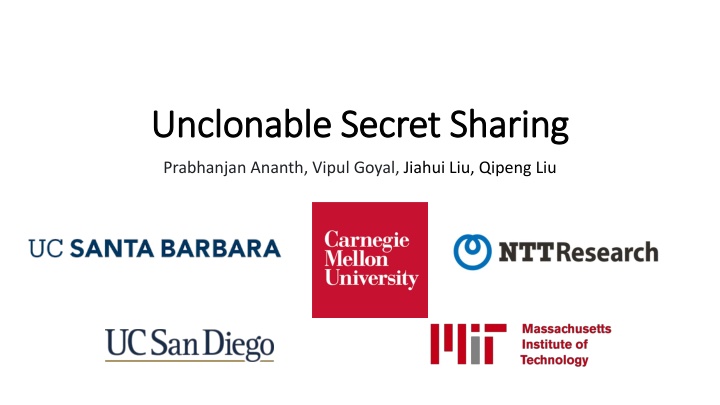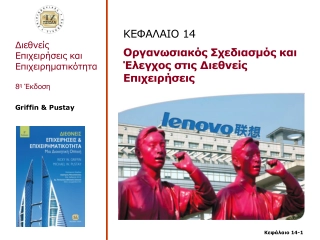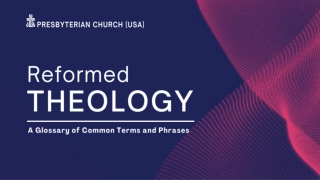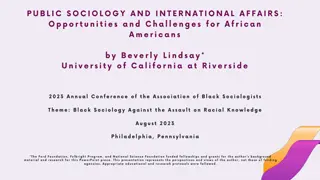
Unclonable Secret Sharing and Quantum Primitives Overview
Explore the concept of unclonable secret sharing, its implications in quantum cryptography, and the advancement of quantum primitives such as quantum key distribution and quantum copy-protection. Discover the potential of unclonable encryption in preventing data copying by cloud servers, and delve into the proposal of defining and achieving unclonable secret sharing. Delve into the talk outlines discussing the definition of unclonable secret sharing, its impact on unclonable encryption and position verification, and the presentation of negative and positive results in this innovative field.
Uploaded on | 2 Views
Download Presentation

Please find below an Image/Link to download the presentation.
The content on the website is provided AS IS for your information and personal use only. It may not be sold, licensed, or shared on other websites without obtaining consent from the author. If you encounter any issues during the download, it is possible that the publisher has removed the file from their server.
You are allowed to download the files provided on this website for personal or commercial use, subject to the condition that they are used lawfully. All files are the property of their respective owners.
The content on the website is provided AS IS for your information and personal use only. It may not be sold, licensed, or shared on other websites without obtaining consent from the author.
E N D
Presentation Transcript
Unclonable Secret Sharing Unclonable Secret Sharing Prabhanjan Ananth, Vipul Goyal, Jiahui Liu, Qipeng Liu
No-Cloning Theorem |? |? Cloning Machine unknown quantum state |?
Classically Impossible Primitives QKD [BB 84] Quantum Money [Wiesner 69, AC 12, Zhandry 19 ] Quantum Copy-Protection [Aaronson 09, CLLZ 21 ] Signature Token [BS 16, AGKZ 20, CLLZ 21] Unclonable Encryption, Decryption [Gottesman 02, BL 19, GZ 20, CLLZ 21]
Unclonable version of secret sharing? Never considered in literatures Important applications prevent cloud servers from copying your data Classical solution (traceable secret sharing) only deters, does not prevent
Unclonable version of secret sharing? Never considered in literatures Important applications prevent cloud servers from copying your data Classical solution (traceable secret sharing) only deters, does not prevent We propose the following question Can we define and achieve unclonable secret sharing?
Talk Outlines Definition of unclonable secret sharing (USS) Implication to unclonable encryption and position verification Negative and Positive Results
Unclonable Secret Sharing (2-party example): Correctness Secret ? Share ?? Share ? ?1,?2 Share ?? ?? ?? Reconstruct ?1,?2 ? ?
Unclonable Secret Sharing (2-party example): Unclonable Unclonable Security Secret ? Share ?? Share ?? ??,? ??,? ??,? ??,? ? ?
Unclonable Secret Sharing (?-party): Unclonable Security Secret ? ?? ?? ?? ? ?
More General USS: ?- -out out- -of of- -? collusion collusion Secret ? ?? ?? ?? ? ?
USS: Additional Properties Regular Secret-Sharing Soundness: No (? 1)-size subset of parties can recover one-copy of secret Unclonable Security: Computational vs. Information-theoretic We consider both computational and IT unclonable security in our paper
USS: allow entanglement entanglement between parties Secret ? ?? ?? ?? No communication But entangled! ? ?
USS: different entanglement entanglement between parties Entanglement graph: divide parties into disjoint connected components depending on entanglement Secret ? ????: ? disjoint components, Inside component: mutually entangled ?? ?? ?? ? ?
USS: allow entanglement entanglement between parties Different entanglement graphs: the fewer components, the more secure the USS protocol is, but more difficult to prove ????: easier to achieve when ? gets larger (more unentangled components) ???1: most challenging (all entangled) Trivial implication: ???1 ???2 ????
Application 1: Unclonable Encryption Alice |???(?) ?? ?? Charlie Bob ? ?
Application 1: Unclonable Encryption UE implies 2-out-of-2 ???2 Two parties; no entanglement, information-theoretic ???1 implies UE: with entanglement, information-theoretic Reverse direction does NOT hold in IT setting
Application 2: Quantum Position Verification I am at 0.5. |?? ? ? ? ???1 implies Position verification (against entangled adversaries)
Negative Result 1: Fully-IT ???1 impossible If all parties have unbounded entanglement & computation & memory resources: ???1 is impossible! General Attack using: Port-based teleportation + Standard teleportation Require entanglement/computation/memory all be exponentially large
Positive Result 1: ????(log?) , IT-secure Share(?): 1. 2. 3. Classically share ? into (? 1) classical shares, ? = ?(log ?) Encode each share into BB84 states (conjugate coding) with random basis The ?-th share is the basis information Reconstruct: 1. Recover all classical shares by measuring the first (? 1) shares under basis given in ?-th share 2. Recover ? from classical shares
Positive Result 1: ????(log?) , IT-secure Share(?): 1. 2. 3. Classically share ? into (? 1) classical shares, ? = ?(log ?) Encode each share into BB84 states (conjugate coding) with random basis The ?-th share is the basis information Reconstruct: 1. Recover all classical shares by measuring the first (? 1) shares under basis given in ?-th share Recover ? from classical shares (XOR-ing them) 2. Proof: (New) XOR repetition lemma of cloning BB84 states Has to XOR all classical secrets in each state together to learn ?
Negative Result 2: Low-T count Reconstruct ???1 impossible T gate is one of the gate in the universal quantum gate set Essential for achieving universal quantum computation A quantum circuit without T gates can be classically simulated A key quantum resource If honest Reconstruct algorithm has only (log ?) T-gates: ???1 (fully entangled, efficient adversaries) is impossible! Gate teleportation tricks
Positive Result 2: ???1 in QROM Unclonable encryption + Quantum Random Oracle Model ???1 (k-party, fully entangled, query-bounded adversaries) High-level Idea: Reconstruct requires using random oracle Random functions are high T-depth and computationally-hard to evaluate in teleportation attacks






















